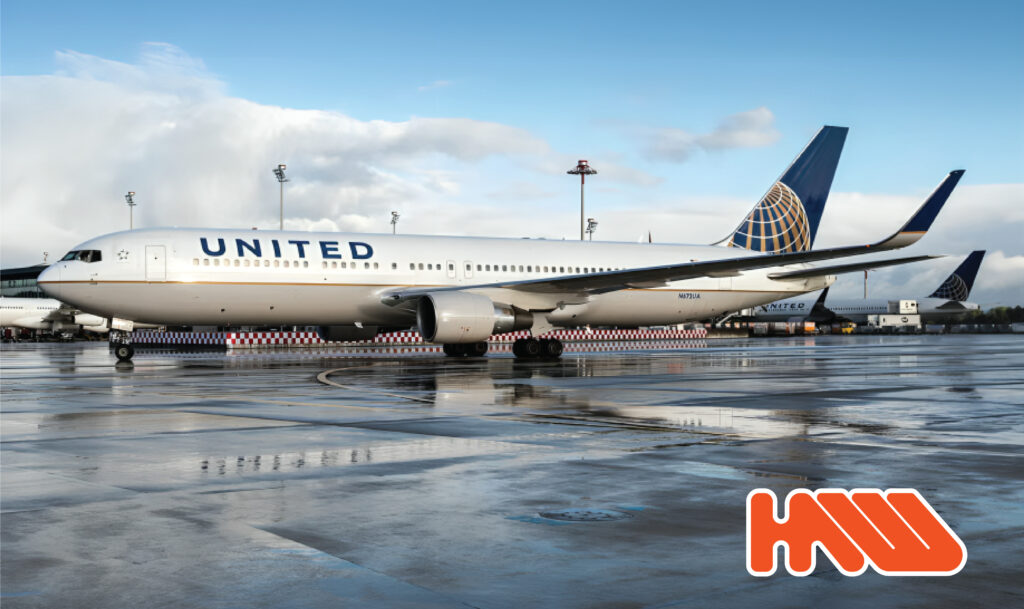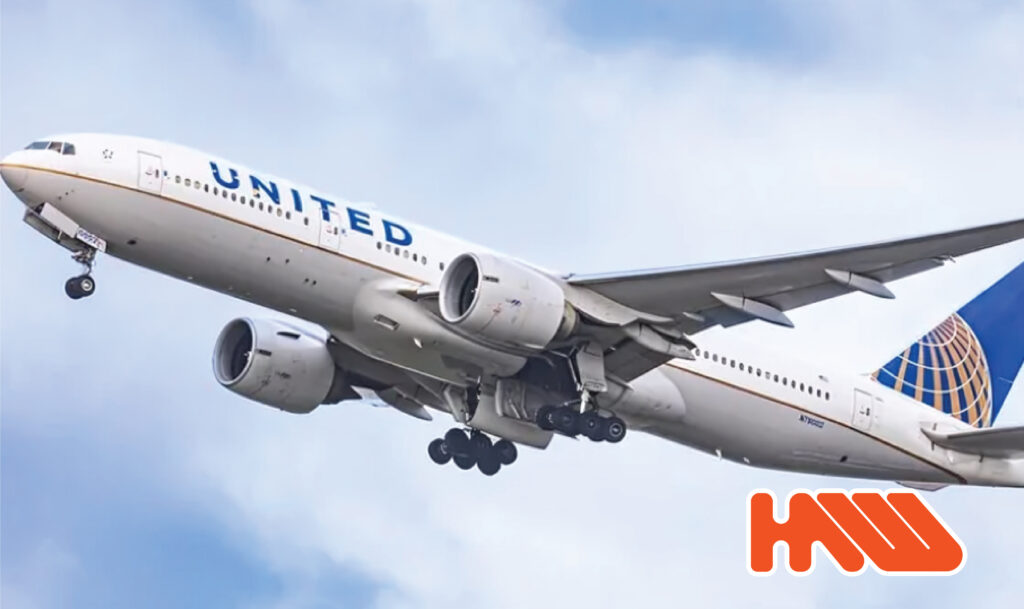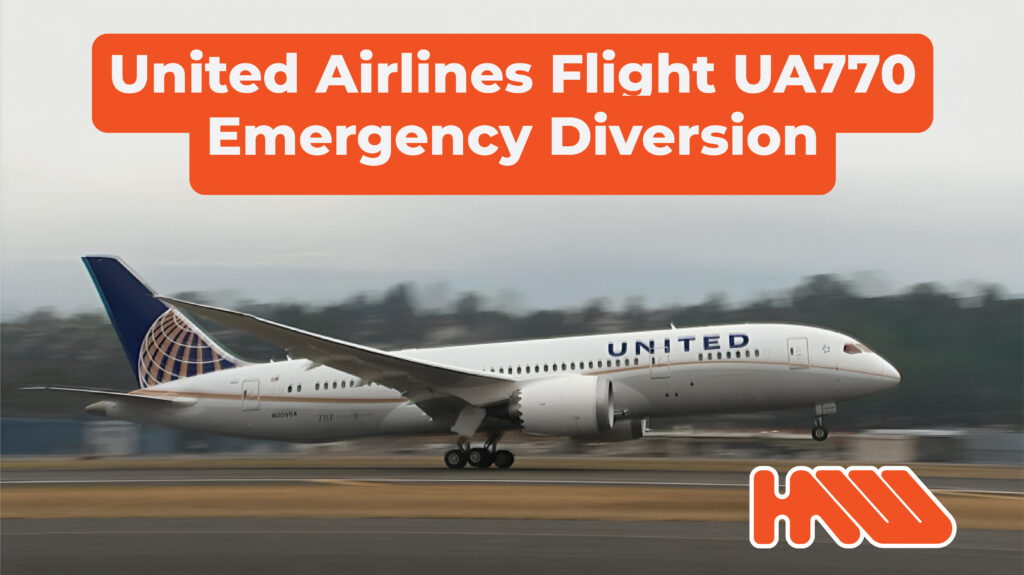Flying at 37,000 feet over the vast Atlantic Ocean, passengers aboard United Airlines Flight 770 were cruising smoothly from Barcelona to Chicago. Suddenly, an alert in the cockpit signaled a potential issue, forcing the pilots into immediate action. This single event triggered a chain reaction of protocols, culminating in the United Airlines Flight UA770 Emergency Diversion. While the term “emergency” often conjures images of panic, this incident was a testament to modern aviation safety, pilot training, and international cooperation. This report delves into the complete story, exploring not just what happened, but why it happened and what it means for the airline industry.
A Mid-Air Alert Over the Atlantic
On July 21, 2025, United Airlines Flight 770, operated by a state-of-the-art Boeing 787-9 Dreamliner (registration N26902), was proceeding normally on its transatlantic journey. High above the ocean, the flight crew received an indication of a cabin pressurization anomaly. This is a critical alert, as maintaining cabin pressure is essential for the safety and comfort of everyone on board at high altitudes.
Faced with this situation, the pilots followed their extensive training and standard operating procedures. They immediately broadcast the transponder code “squawk 7700”. This four-digit code is the universal signal for a general emergency, instantly alerting air traffic controllers on the ground that the aircraft requires priority handling and may need to deviate from its planned route. The decision was made swiftly: the flight would divert to the nearest suitable airport, which was determined to be London Heathrow (LHR). This decisive action marked the official start of the United Airlines Flight UA770 Emergency Diversion.
A Textbook Precautionary Landing
A crucial detail that redefines the narrative of this event is that the passenger oxygen masks did not deploy. In modern airliners, these masks are designed to drop automatically if the cabin altitude exceeds a specific threshold, typically around 14,000 feet. The fact they remained stowed indicates that there was no sudden or catastrophic loss of cabin pressure.

This suggests the pilots detected a fault in the system long before it escalated into a more dangerous scenario. The diversion was not a last-ditch effort to save a failing aircraft, but a proactive and precautionary measure. By initiating the United Airlines Flight UA770 Emergency Diversion early, the crew ensured they could execute a controlled descent and safe landing, prioritizing the well-being of their passengers above all else.
Coordinated Response: A Symphony of Safety
The moment “squawk 7700” was declared, a network of aviation professionals sprang into action. Eurocontrol, the agency managing European airspace, seamlessly coordinated with air traffic controllers in Spain, France, and the United Kingdom. They cleared a path for the Boeing 787, guiding it safely through some of the world’s busiest skies.
On the ground at Heathrow, the airport’s emergency protocols were activated. Fire and rescue services, medical teams, and airline engineers were placed on standby, ready to respond to any contingency upon the aircraft’s arrival. The flight touched down safely on Runway 27R at approximately 4:55 PM local time, a testament to the seamless integration of pilot, air traffic control, and airport operations. The successful handling of the United Airlines Flight UA770 Emergency Diversion showcased the robust safety net that underpins modern air travel.
The Aircraft: A Glimpse into the Boeing 787’s Technology
The aircraft at the center of this incident, the Boeing 787 Dreamliner, is one of the most technologically advanced commercial jets in service. A key feature is its revolutionary “no-bleed” cabin pressurization system. Unlike older aircraft that use hot air “bled” from the engines, the 787 uses dedicated electric compressors to pull in outside air and pressurize the cabin.
This all-electric system is more fuel-efficient and allows for a lower cabin altitude (6,000 feet vs. the standard 8,000), which enhances passenger comfort. However, its complexity also introduces new potential points of failure, including sensors, software, and the electric compressors themselves. The very sophistication that provides a more comfortable flight also demands a higher level of monitoring. The early warning that triggered the United Airlines Flight UA770 Emergency Diversion was likely a product of these advanced monitoring systems working exactly as designed.
The Passenger Experience: Calm Professionalism
According to passengers on board, the atmosphere in the cabin was tense but well-managed. The cabin crew was repeatedly praised for their professionalism and composure. They provided regular updates to the passengers, helping to prevent anxiety and maintain a calm environment throughout the diversion and landing.
Upon disembarking at Heathrow, passengers were met by United Airlines ground staff. The airline promptly activated its customer support plan, providing hotel accommodations, meal vouchers, and assistance with rebooking onto subsequent flights to Chicago. This response, aligned with EU261 passenger rights regulations, helped mitigate the disruption and demonstrated the airline’s commitment to customer care during the unexpected United Airlines Flight UA770 Emergency Diversion.
The Official Record: Why No Formal Investigation?
A key question that often arises after such an incident is about the official investigation. However, a search of records from the US National Transportation Safety Board (NTSB) and the UK’s Air Accidents Investigation Branch (AAIB) reveals no formal report on this specific event.
This absence is, in itself, informative. These agencies typically launch a full investigation only when an incident involves serious injuries, fatalities, or substantial damage to the aircraft. The fact that the United Airlines Flight UA770 Emergency Diversion concluded without meeting these criteria reinforces its classification as a precautionary landing. The issue was resolved safely by the crew and the airline’s maintenance teams without escalating to the level of a major aviation accident.
A Wider Context: A Pattern of Scrutiny
While the United Airlines Flight UA770 Emergency Diversion was a standalone event handled with great professionalism, it did not occur in a vacuum. In the months and years preceding this incident, United Airlines had come under increased oversight from the Federal Aviation Administration (FAA) due to a series of unrelated safety-related events.

This pattern included a range of issues, from an uncontained engine failure over Denver in 2021, which the NTSB linked to inadequate inspections, to a flight over Hawaii in 2022 that plunged towards the ocean due to pilot error. Other incidents, such as a lost wheel on takeoff and a missing external panel, contributed to the FAA’s decision to intensify its scrutiny of the airline’s operations, maintenance, and safety procedures.
Each Incident Adds to the Narrative
For regulators, a single, well-managed technical issue is a data point. However, a series of varied incidents across different aircraft types and involving different causes—from maintenance to pilot error to technical faults—can suggest a more systemic issue within an airline’s Safety Management System (SMS).
Aviation experts have noted that United’s aggressive growth plans, involving the acquisition of hundreds of new aircraft and rapid route expansion, could be placing a strain on its operational resources. In this context, every event, no matter how well it is resolved, becomes another chapter in an ongoing story. The United Airlines Flight UA770 Emergency Diversion thus became another critical piece of evidence for regulators assessing the airline’s ability to maintain the highest safety standards amidst expansion.
A Paradoxical Event: Success and Symptom
The United Airlines Flight UA770 Emergency Diversion is best understood as a paradox. On one hand, it was a resounding operational success. Advanced aircraft systems provided an early warning, a highly skilled crew made a decisive and correct call, and a global network of aviation professionals ensured a safe outcome. It is a perfect case study of how the layers of aviation safety are designed to work in harmony to prevent disaster.
On the other hand, the incident serves as a symptom of a larger challenge. It represents another operational interruption for an airline already under a regulatory microscope. It highlights the unique failure modes of new-generation aircraft and underscores the immense pressure on airlines to manage technical complexity, rigorous maintenance schedules, and comprehensive pilot training. The successful outcome of the United Airlines Flight UA770 Emergency Diversion does not erase it from the logbook of events that regulators scrutinize.
Conclusion
Ultimately, the story of the United Airlines Flight UA770 Emergency Diversion is one of exemplary risk management. No one was injured, and the aircraft landed safely. The crew’s actions were a credit to their training and professionalism. However, its true significance is revealed when viewed within the broader context of the airline’s operational record and the FAA’s heightened oversight.
The incident serves as a vital lesson for the entire industry about the challenges of integrating technologically advanced aircraft into a rapidly expanding global network. It reinforces the principle that safety is not merely the absence of accidents, but the presence of robust, proactive systems designed to manage risk. The United Airlines Flight UA770 Emergency Diversion will be remembered not for the crisis that could have been, but for the crisis that was expertly and successfully averted, while still providing valuable data for ensuring the future of aviation remains as safe as possible. The final analysis of the United Airlines Flight UA770 Emergency Diversion is one of cautious optimism, celebrating the success while acknowledging the underlying challenges it represents.
Frequently Asked Questions (FAQs)
1. What caused the United Airlines Flight UA770 emergency diversion?
The diversion was caused by a cabin pressurization anomaly detected by the flight crew’s instruments. This prompted them to take precautionary action.
2. Were passengers in any real danger?
No. The diversion was a proactive safety measure. The fact that passenger oxygen masks did not deploy indicates there was no sudden or severe loss of cabin pressure.
3. Where did Flight UA770 land after the emergency was declared?
The flight safely diverted to London Heathrow Airport (LHR), the nearest suitable airport equipped to handle the situation.
4. Why isn’t there an official investigation report from the NTSB or AAIB?
Major safety agencies only launch formal investigations for incidents involving serious injury or substantial aircraft damage. Since this event concluded safely without meeting those criteria, it was classified as a precautionary landing and handled internally.
5. What happened to the passengers after landing in London?
United Airlines provided passengers with hotel accommodations, meal vouchers, and assistance with rebooking them on the next available flights to their final destination in Chicago.
Curious for more? Dive deeper on our site now! Http News Well

